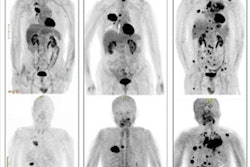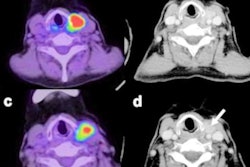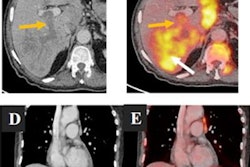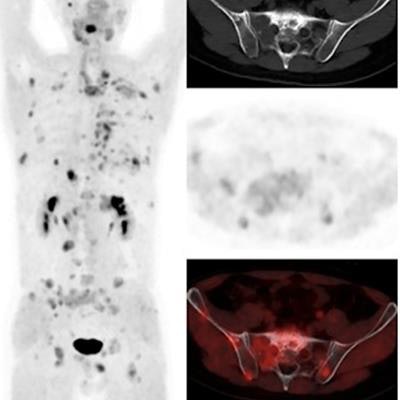
Researchers in China have developed a PET radiotracer that binds to two established diagnostic targets in patients with cancer and suggest this "dual-receptor-targeting" ability may have advantages over current approaches, according to a recent study.
A group led by Dr. Liang Zhao of Xiamen University synthesized a gallium-68 (Ga-68)-based heterodimer tracer by combining key peptides used to create single fibroblast activation protein inhibitor (FAPI) and arginine-glycine-aspartic (RGD) radiotracers. In a study including 22 patients receiving PET/CT exams, the new tracer (Ga-68 FAPI-RGD) showed promise, according to the findings.
"Our clinical studies demonstrated Ga-68 FAPI-RGD to be a promising PET agent that allows imaging of various types of cancer," the group wrote in a study published May 4 in the Journal of Nuclear Medicine. "Its dual-receptor-targeting property results in improved tumor uptake and retention, allowing imaging of tumors with either or both receptor expression patterns."
PET/CT imaging with the F-18 FDG radiotracer is the gold standard in cancer imaging, yet the tracer exhibits low to moderate uptake in certain types, including gastric, pancreatic, and liver cancers. Recently, FAPI-based radiotracers (including FAPI-04 and FAPI-46) that bind specifically to FAP protein on cancer cells have been developed and have yielded encouraging results; likewise, RGD peptide-based tracers that bind to integrin alpha-v beta-3 (a glycoprotein) on cancer cells have also proven more specific. However, the rapid blood clearance of both tracers has limited their clinical use, the authors explained.
Based on results of a previous animal study, the group hypothesized that a synthesized heterodimer tracer that recognizes both FAP and integrin alpha-v beta-3 would be advantageous because of its dual-receptor-targeting property.
The researchers prospectively enrolled 22 patients. All patients underwent paired Ga-68 FAPI-RGD and F-18 FDG PET/CT scans, while additional Ga-68 FAPI-46 PET/CT scans were performed for comparative purposes, depending on the patient's willingness. All images were evaluated by two board-certified and experienced nuclear medicine physicians.
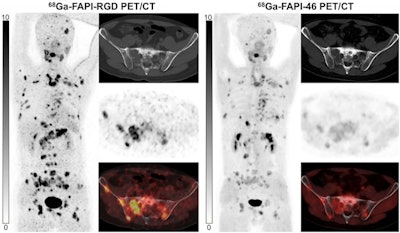 Ga-68 FAPI-RGD PET/CT shows significantly higher radiotracer uptake than Ga-68 FAPI-46 in patient with metastatic thyroid cancer. Image courtesy of the Journal of Nuclear Medicine through CC BY 4.0.
Ga-68 FAPI-RGD PET/CT shows significantly higher radiotracer uptake than Ga-68 FAPI-46 in patient with metastatic thyroid cancer. Image courtesy of the Journal of Nuclear Medicine through CC BY 4.0.Radiotracer uptake and tumor-to-background ratio (TBR) of primary and metastatic tumors in Ga-68 FAPI-RGD PET/CT were significantly higher than those in F-18 FDG PET/CT images. Specifically, Ga-68 FAPI-RGD PET/CT yielded higher lesion detection rates than F-18 FDG PET/CT for diagnosing bone and visceral metastases (96% vs. 79%, p < 0.001).
In addition, Ga-68 FAPI-RGD and Ga-68 FAPI-46 PET/CT were compared among seven patients with five types of cancer. While no statistical difference was observed in use of the two tracers in primary tumors, Ga-68 FAPI-RGD PET/CT performed better than Ga-68 FAPI-46 in lymph node metastases, lung metastases, and bone metastases, according to the findings.
The authors noted that they were unable to compare Ga-68 FAPI-RGD-PET/CT with Ga-68 RGD-PET/CT in the same group of patients, and this may be investigated in future research. Ultimately, the findings and promising and warrant further research, the authors wrote.
"Further investigation of the diagnostic accuracy of Ga-68 FAPI-RGD as a PET tracer, as well as its antitumor efficacy after labeling with therapeutic radionuclides, is necessary," the group concluded.






